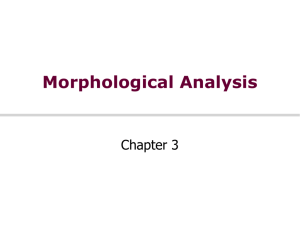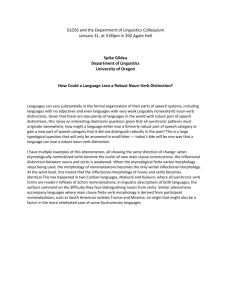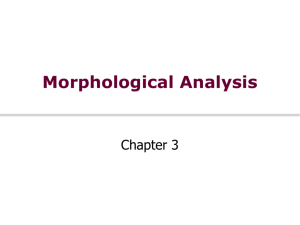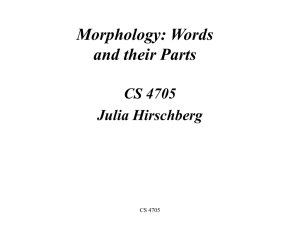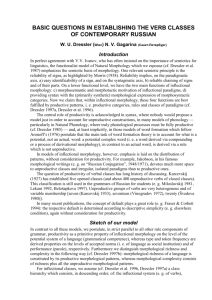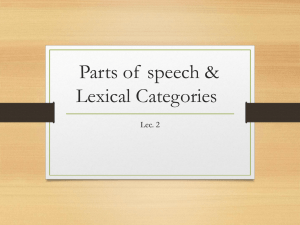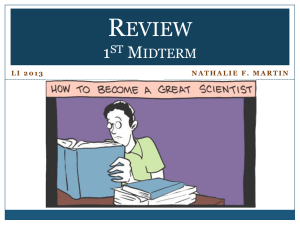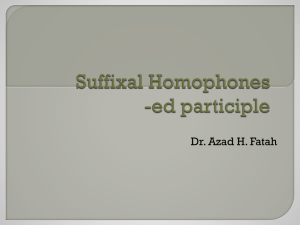04Morphology - Computer Science and Engineering
advertisement
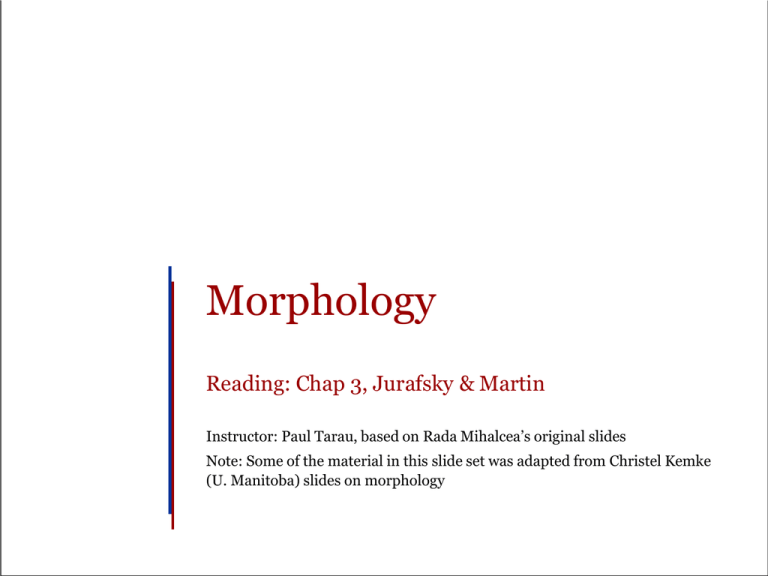
Morphology Reading: Chap 3, Jurafsky & Martin Instructor: Paul Tarau, based on Rada Mihalcea’s original slides Note: Some of the material in this slide set was adapted from Christel Kemke (U. Manitoba) slides on morphology Morphology Morpheme = "minimal meaning-bearing unit in a language" Morphology handles the formation of words by using morphemes – base form (stem), e.g., believe – affixes (suffixes, prefixes, infixes), e.g., un-, -able, -ly Morphological parsing = the task of recognizing the morphemes inside a word – e.g., hands, foxes, children Important for many tasks – machine translation – information retrieval – lexicography – any further processing (e.g., part-of-speech tagging) Slide 1 Morphemes and Words Combine morphemes to create words Inflection combination of a word stem with a grammatical morpheme same word class, e.g. clean (verb), clean-ing (verb) Derivation combination of a word stem with a grammatical morpheme Yields different word class, e.g. clean (verb), clean-ing (noun) Compounding combination of multiple word stems Cliticization combination of a word stem with a clitic different words from different syntactic categories, e.g. I’ve = I + have Slide 2 Inflectional Morphology Inflectional Morphology word stem + grammatical morpheme cat + s only for nouns, verbs, and some adjectives Nouns plural: regular: +s, +es irregular: mouse - mice; ox - oxen rules for exceptions: e.g. -y -> -ies like: butterfly - butterflies possessive: +'s, +' Verbs main verbs (sleep, eat, walk) modal verbs (can, will, should) primary verbs (be, have, do) Slide 3 Inflectional Morphology (verbs) Verb Inflections for: main verbs (sleep, eat, walk); primary verbs (be, have, do) Morpholog. Form stem -s form -ing participle past; -ed participle Regularly Inflected Form walk merge walks merges walking merging walked merged try tries trying tried Morph. Form stem -s form -ing participle -ed past -ed participle Irregularly Inflected Form eat catchcut eats catches eating catching ate caught eaten caught cuts cutting cut cut map maps mapping mapped Slide 4 Inflectional Morphology (nouns) Noun Inflections for: regular nouns (cat, hand); irregular nouns(child, ox) Morpholog. Form stem plural form Regularly Inflected Form cat hand cats hands Morph. Form stem plural form Irregularly Inflected Form child ox children oxen Slide 5 Inflectional and Derivational Morphology (adjectives) Adjective Inflections and Derivations: prefix suffix suffix un-ly -er -est -ness unhappy happily happier happiest happiness adjective, negation adverb, mode adjective, comparative 1 adjective, comparative 2 noun plus combinations, like unhappiest, unhappiness. Distinguish different adjective classes, which can or cannot take certain inflectional or derivational forms, e.g. no negation for big. Slide 6 Derivational Morphology (nouns) Slide 7 Derivational Morphology (adjectives) Slide 8 Verb Clitics Slide 9 Methods, Algorithms Stemming Stemming algorithms strip off word affixes yield stem only, no additional information (like plural, 3rd person etc.) used, e.g. in web search engines famous stemming algorithm: the Porter stemmer Slide 11 Stemming Reduce tokens to “root” form of words to recognize morphological variation. “computer”, “computational”, “computation” all reduced to same token “compute” Correct morphological analysis is language specific and can be complex. Stemming “blindly” strips off known affixes (prefixes and suffixes) in an iterative fashion. for example compressed and compression are both accepted as equivalent to compress. for exampl compres and compres are both accept as equival to compres. Slide 12 Porter Stemmer Simple procedure for removing known affixes in English without using a dictionary. Can produce unusual stems that are not English words: “computer”, “computational”, “computation” all reduced to same token “comput” May conflate (reduce to the same token) words that are actually distinct. Does not recognize all morphological derivations Typical rules in Porter stemmer sses ss ies i ational ate tional tion ing → Slide 13 Stemming Problems Errors of Comission Errors of Omission organization organ European Europe doing doe analysis analyzes Generalization Generic Matrices matrix Numerical numerous Noise noisy Policy police sparse sparsity Slide 14 Tokenization, Word Segmentation Tokenization or word segmentation separate out “words” (lexical entries) from running text expand abbreviated terms E.g. I’m into I am, it’s into it is collect tokens forming single lexical entry E.g. New York marked as one single entry More of an issue in languages like Chinese Slide 15 Simple Tokenization Analyze text into a sequence of discrete tokens (words). Sometimes punctuation (e-mail), numbers (1999), and case (Republican vs. republican) can be a meaningful part of a token. However, frequently they are not. Simplest approach is to ignore all numbers and punctuation and use only case-insensitive unbroken strings of alphabetic characters as tokens. More careful approach: Separate ? ! ; : “ ‘ [ ] ( ) < > Care with . - why? when? Care with … ?? Slide 16 Punctuation Children’s: use language-specific mappings to normalize (e.g. AngloSaxon genitive of nouns, verb contractions: won’t -> wo ‘nt) State-of-the-art: break up hyphenated sequence. U.S.A. vs. USA a.out Slide 17 Numbers 3/12/91 Mar. 12, 1991 55 B.C. B-52 100.2.86.144 Generally, don’t index as text Creation dates for docs Slide 18 Lemmatization Reduce inflectional/derivational forms to base form Direct impact on vocabulary size E.g., am, are, is be car, cars, car's, cars' car the boy's cars are different colors the boy car be different color How to do this? Need a list of grammatical rules + a list of irregular words Children child, spoken speak … Practical implementation: use WordNet’s morphstr function Perl: WordNet::QueryData (first returned value from validForms function) Slide 19 Morphological Processing Knowledge lexical entry: stem plus possible prefixes, suffixes plus word classes, e.g. endings for verb forms (see tables above) rules: how to combine stem and affixes, e.g. add s to form plural of noun as in dogs orthographic rules: spelling, e.g. double consonant as in mapping Processing: Finite State Transducers take information above and analyze word token / generate word form Slide 20 Fig. 3.3 FSA for verb inflection. Slide 21 Fig. 3.4 Simple FSA for adjective inflection. Fig. 3.5 More detailed FSA for adjective inflection. Slide 22 Fig. 3.7 Compiled FSA for noun inflection. Slide 23
